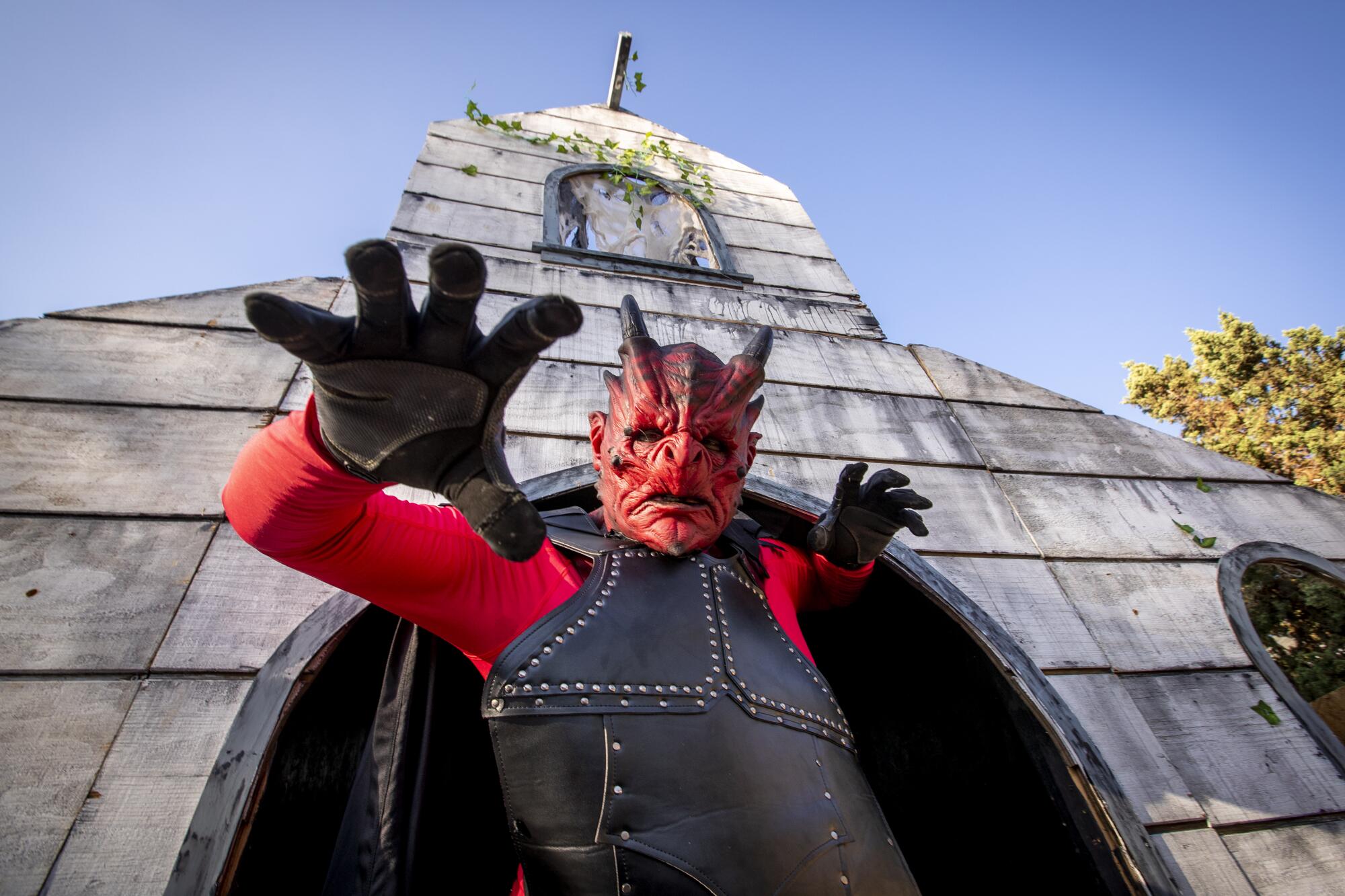
- Share via
Overripe pomegranates bloodied the sidewalk, the fleshy rot of fallen guava perfuming the air, as Jesus Garcia and his skeleton crew surveyed their sleepy block of Santa Ana.
Suddenly, Eduardo “Chongo” Camarena began to scream.
“Homie, what’s going on?” the 29-year-old cried out, his long black braid swinging as he lurched away from Joshua “Screw Loose” Shibley, 28. “Yo … Get the — away!” Camarena bellowed, panic rising in his voice. “Hey, help! Help!”
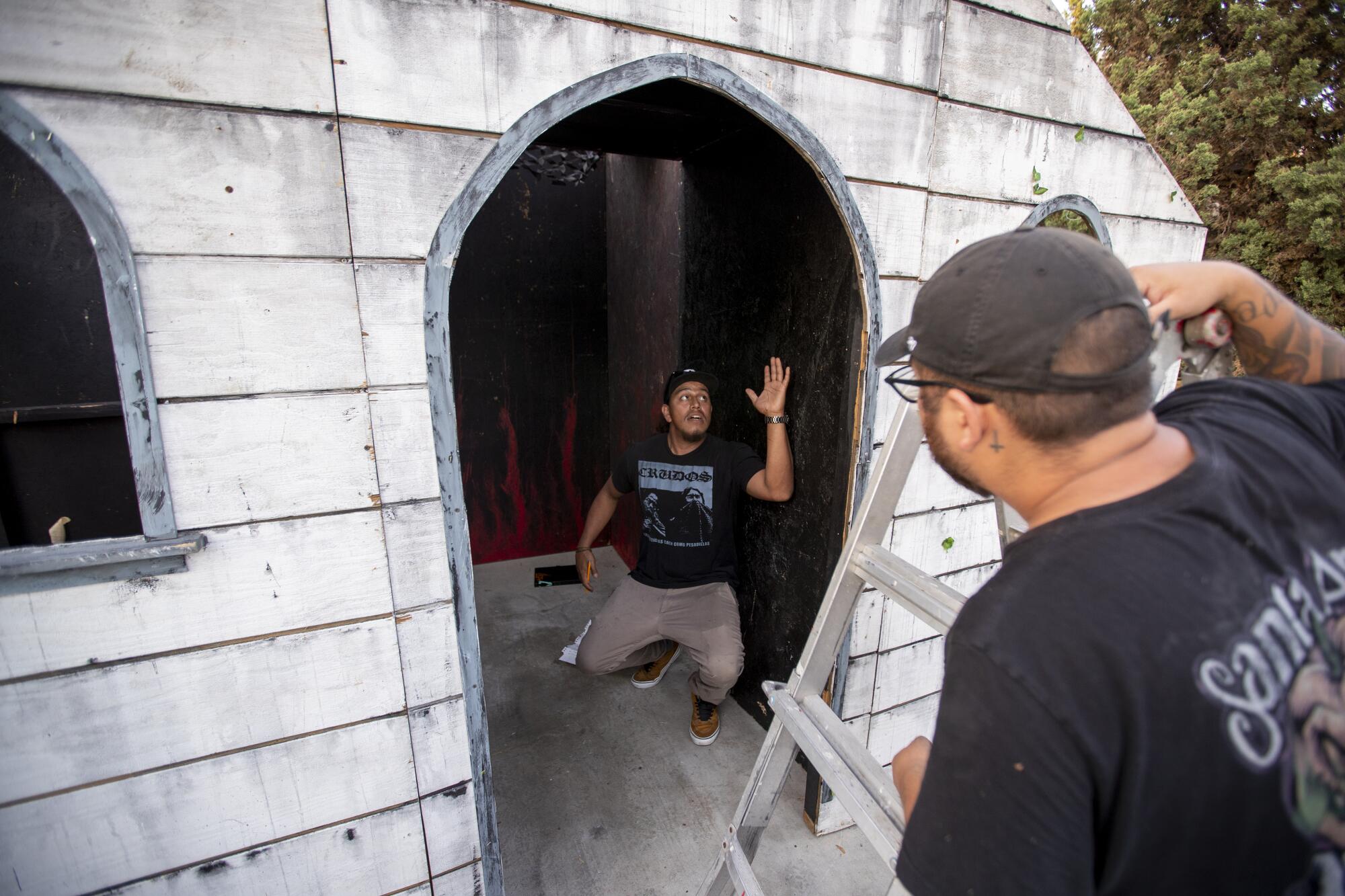
The rest of the crew looked on, impassive. A mail carrier continued his rounds. Shibley grabbed the top of Camarena’s head and twisted his face away, exposing his throat.
“Oh, you are delicious,” Shibley crooned, stroking Camarena’s skin. “Let’s just take your neck...”
His victim dissolved into hysterical laughter.
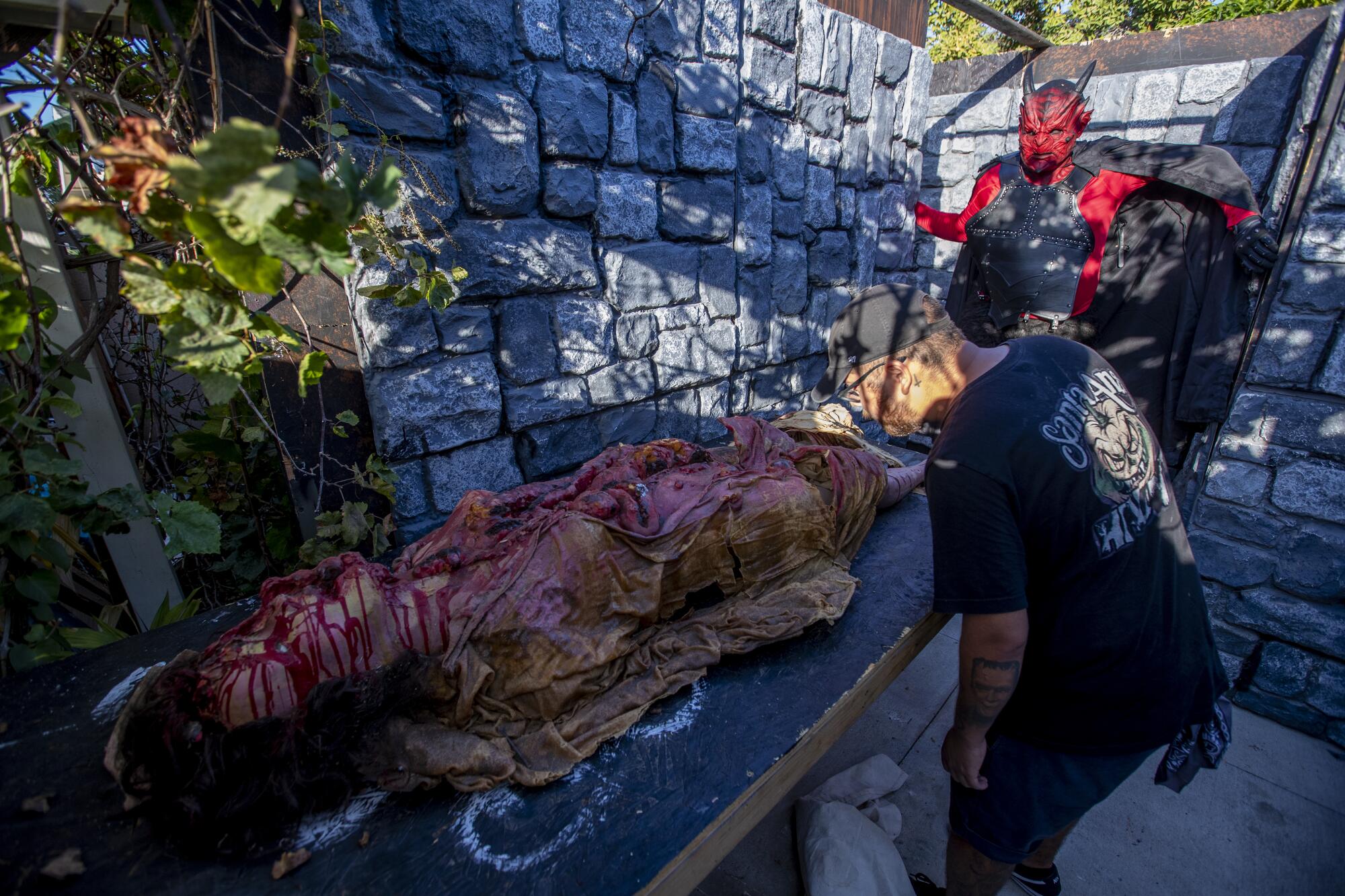
The pair were auditioning for Shades of Hell, the horror maze they’d helped build among the prickly pear in Garcia’s father’s suburban yard. It’s one of hundreds of amateur “home haunts” that rise across the Southland every fall.
But this autumn is different, the haunters say. From theme park scare-actors to cemetery aestheticians, professional ofrenda artists to part-time evil clowns, the people who breathe life into Southern California’s spooky season every year are gearing up for an October like no other now that pandemic precautions have eased.
“People are trying to make up for lost time,” said Rick West, co-founder of the Halloween and horror convention Midsummer Scream. “We’re seeing that every event, every show, everything seems to be through the roof.”
Spooky festivities have also expanded, part of what’s sometimes called “season creep.” Originally coined to describe the effects of climate change, season creep now also refers to “Santa Baby” in September and pumpkin spice on Independence Day.
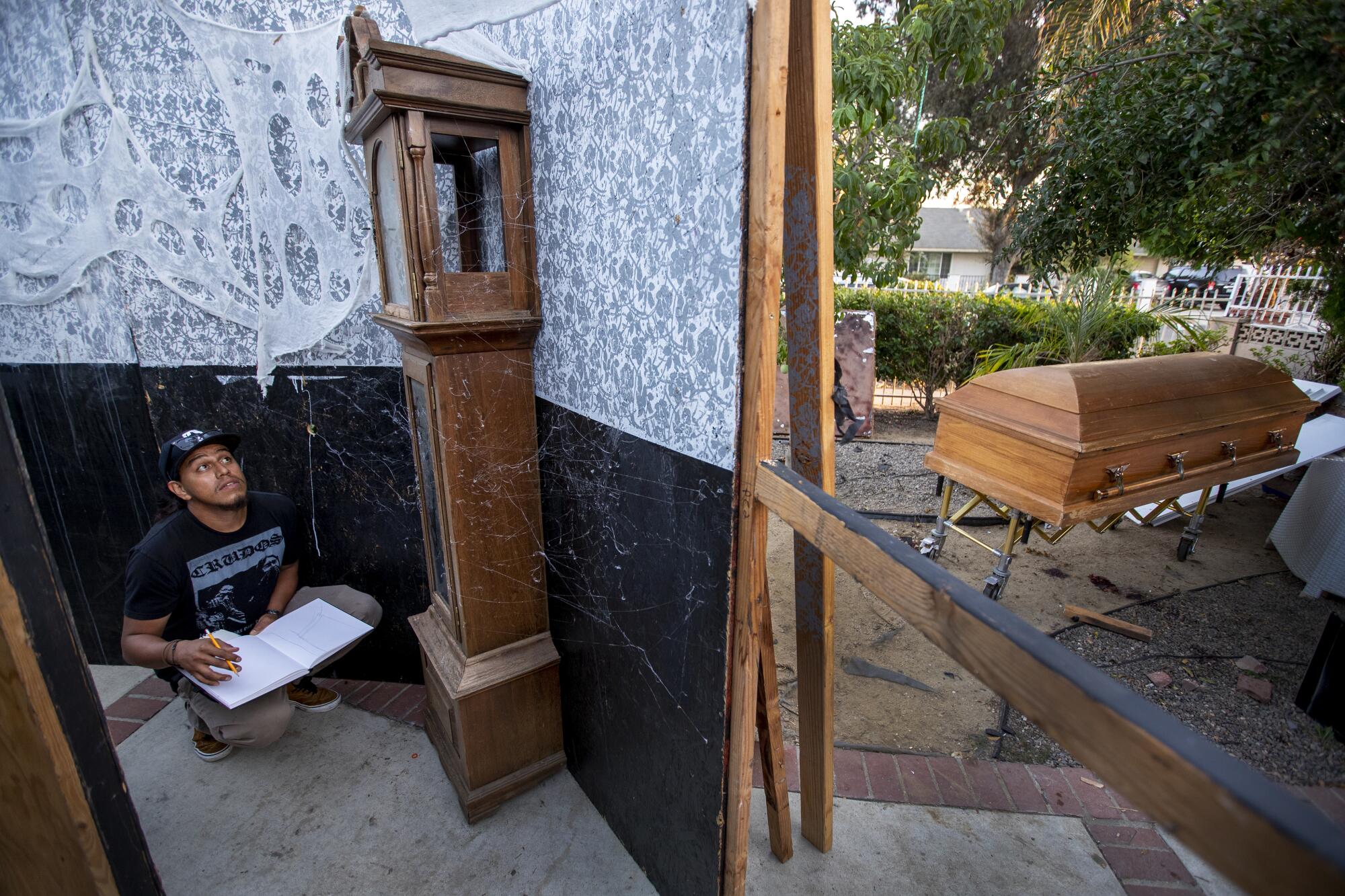
Valley Fright Nights, a trio of haunted houses at Pierce College, opened in late July. The skull-painting Catrinas of H&MUA Studio in Paramount are booked through mid-November.
Santa Ana Haunt is no exception. Garcia expects more than 2,000 people to pass through Shades of Hell for its third and final run this Thursday through Halloween. Leading up to opening day on Oct 21, his crew of two dozen spent every spare moment perfecting new scares.
There will be live dubia roaches, which grow to nearly 2 inches; Satan on stilts; a homicidal jester with sparking gloves. And now, Camarena’s howling victim.
“Dude! That’s what we’re gonna do,” Garcia shouted approvingly. It was a bravura performance — in his enthusiasm, Camarena almost broke a nearby fence — but his voice would be gone if he didn’t improve his screams by opening night.
“Real quick, I’m gonna have you rendezvous with them over here,” Garcia went on, gesturing to scare actors David Matchell and Wendy J. Garibay, veterans of the SoCal horror scene. “They’re going to show you how to use your diaphragm and not your throat.”
If there’s one thing the haunters would need to survive this year’s spooky season, it’s stamina.
::
But what is going on?
Why are autumn holidays ascendant? And when did they get so long? What brought spooky fever to Southern California, where 72 degrees is sweater weather and the only crunch underfoot is the crack of fallen palm fruit?
“We’re a big entertainment city, and a lot of people who work in the industry like Halloween as an excuse to blow off steam,” said Derek Young, founder of Southern California Haunt List, a home haunt aggregator. “It’s in the middle of summer because it’s always summer here.”
L.A. artists and activists have found similar inspiration in Día de los Muertos. But demographics have helped push that holiday into the mainstream.
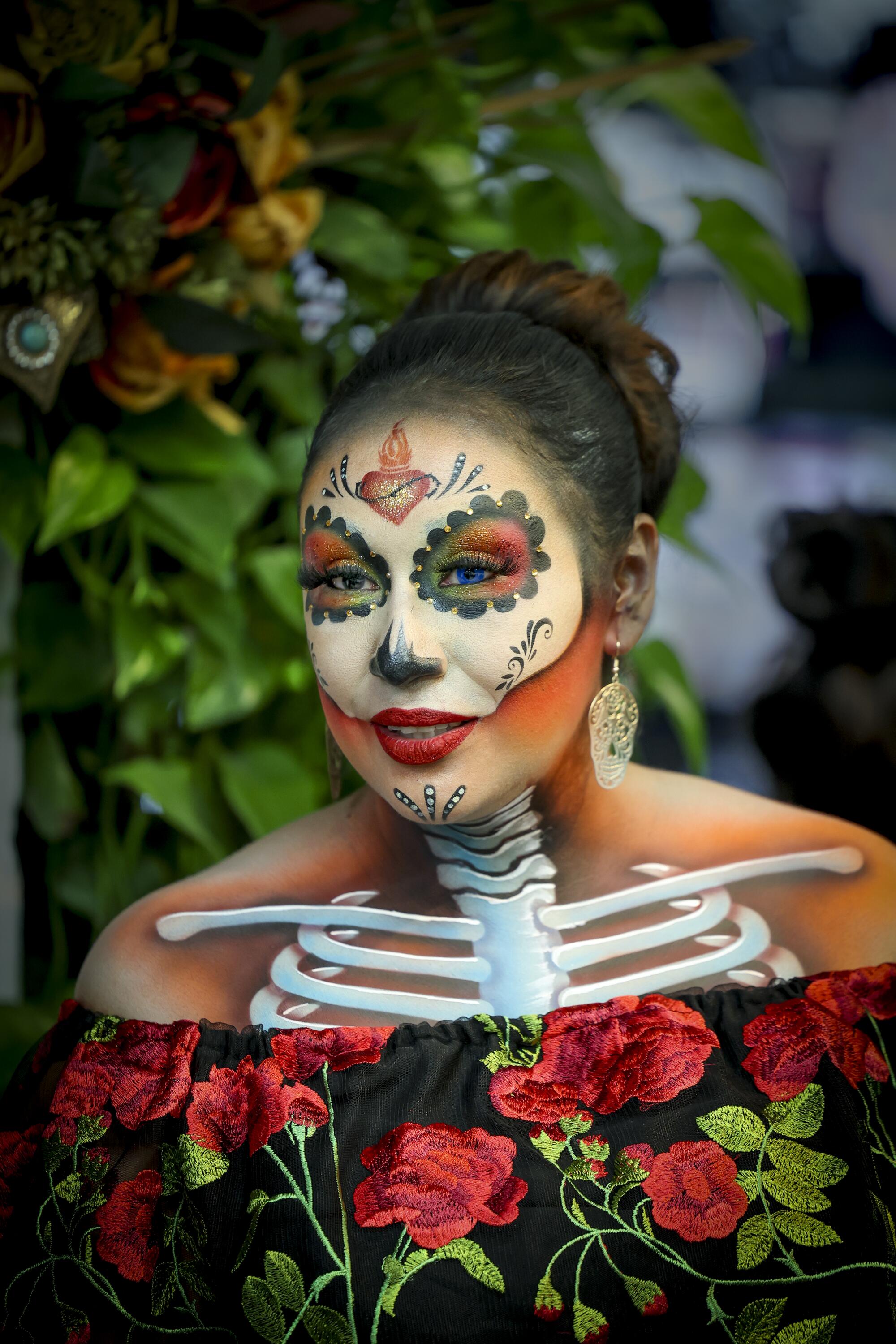
In Los Angeles, “people feel so immersed in Latino and Chicano culture that participating in something like Day of the Dead becomes second nature,” said professor Mathew Sandoval, a scholar of culture and performance studies at Arizona State University who studies Day of the Dead celebrations in the United States. “It just comes with being an Angeleno.”
While Halloween (Oct. 31) and Día de los Muertos (Nov. 1-2) remain culturally and historically distinct, their celebrations increasingly take place on top of each other.
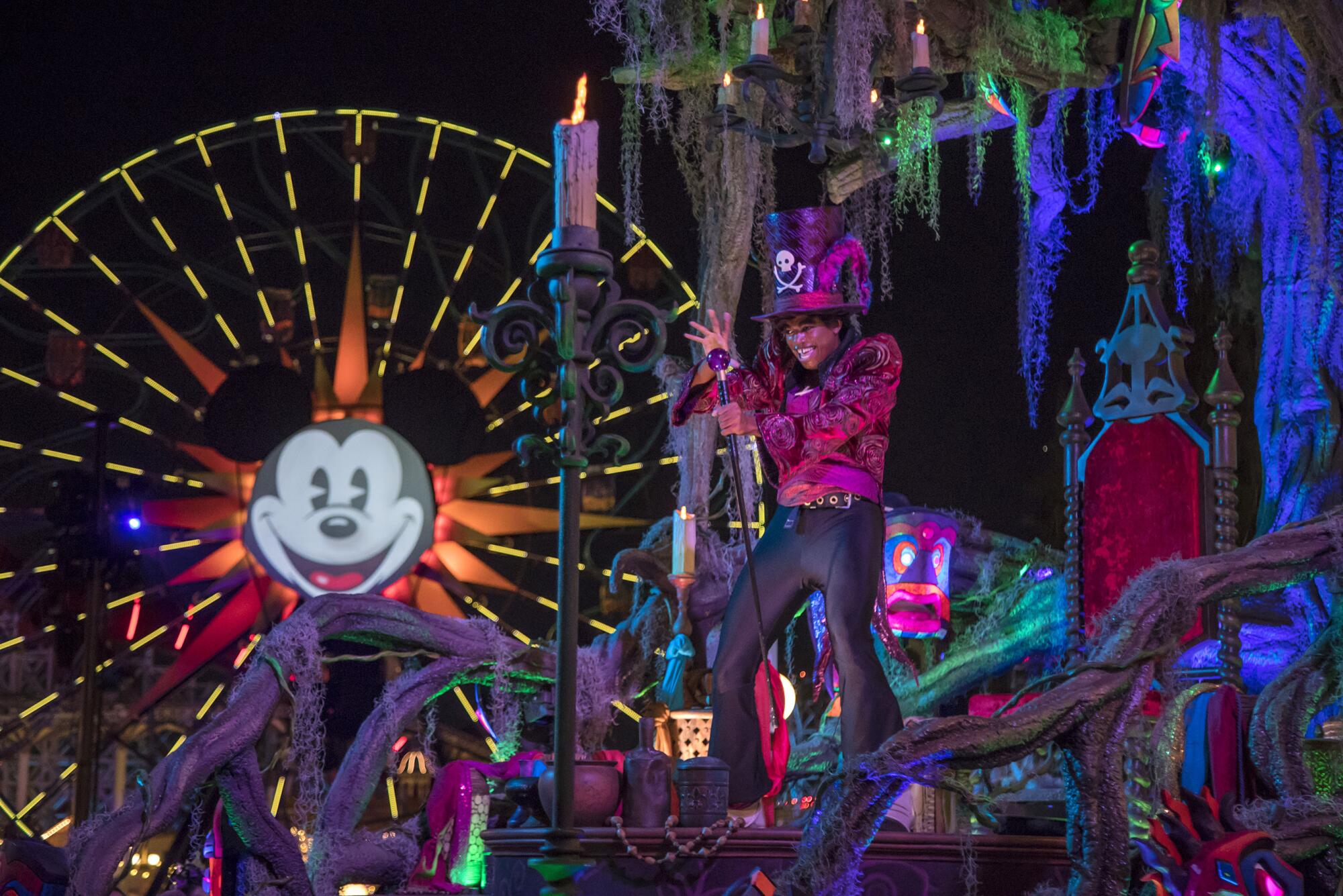
At Disney’s California Adventure, just five miles from Garcia’s horror maze, the Nightmare Before Christmas-themed Oogie Boogie Bash Halloween party runs virtually concurrent to the park’s Muertos offering, the Coco-inspired Plaza de la Familia.
Costumes too increasingly overlap.
“A major development I’ve seen in L.A. is the magnitude of the costuming — that’s a newer tradition,” Sandoval said. “There’s a common misperception that the history of Day of the Dead is people dressing up as skeletons and skulls, but that’s a recent phenomenon.”
That aesthetic emphasis also brings L.A.’s Day of the Dead squarely into Shibley’s spooky season fan matrix.
“A lot of people like … anything scary,” he said. “And then there’s other people who just like a goth aesthetic, and then there’s other people who like costumes and there’s other people who like candy.”
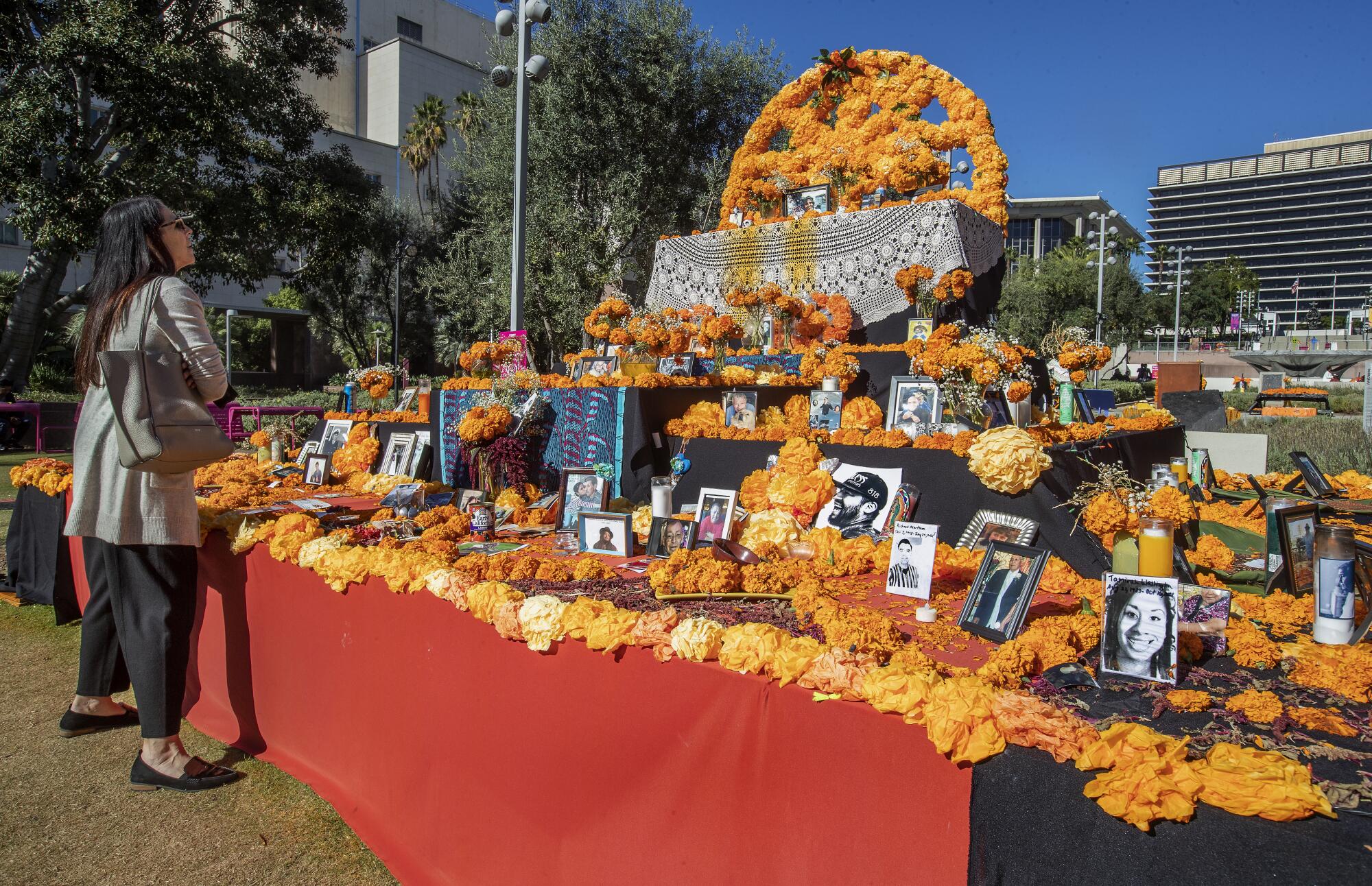
According to the National Retail Federation, a trade association that tracks holiday spending, most Americans fall into Category 4. But as a demographic, U.S. Latinos are also fiends for horror.
“They’re a big population for horror movies,” comprising 30% or more of the audience, said Renee Hudson, an assistant professor of English at Chapman University who studies the genre.
Like many Chicanos, she didn’t grow up celebrating Día de los Muertos, which is rooted in indigenous customs, mixed with Catholic observance.
But she did grow up with “The Exorcist.”
“My sisters and I always loved horror, it was what we were always into,” she said. “We just want to be in the living room, popcorn and soda, all the lights off watching scary [movies].”
For those who love them, autumnal traditions offer a respite from the relentless Christmas creep. After all, no one lies awake at night dreading Day of the Dead.
“Halloween marks the edge where Christmas can’t go anymore,” Shibley said. “Spooky b—s hold the line.”
::
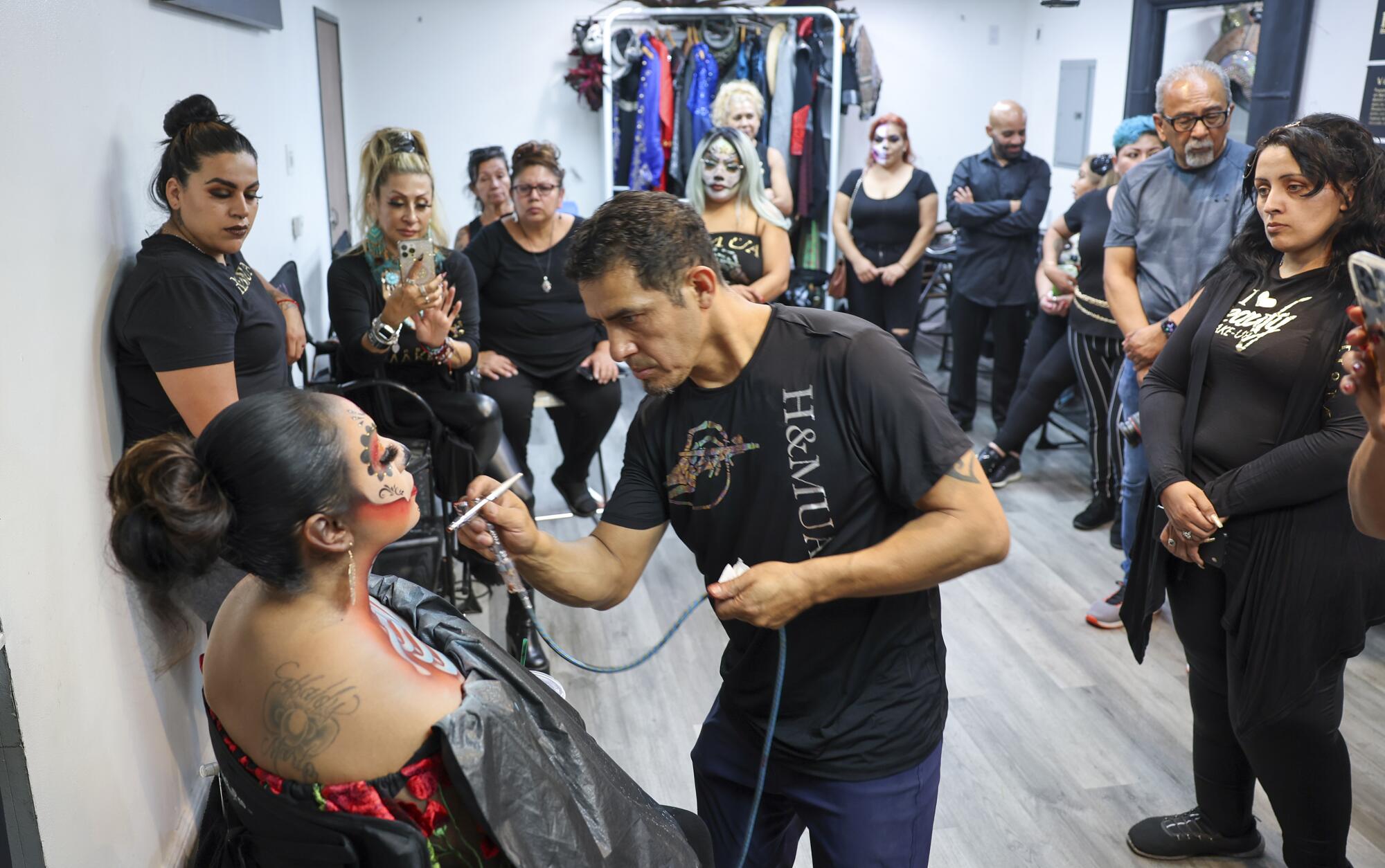
Denise Romero reclined in the salon chair, smoothing her black folklórico dress and stealing glances in a hand mirror as L.A.’s preeminent Catrina makeup maestro transformed her into a cadaver.
“If you look here, this line — this is the clavicle,” muralist-turned-makeup-artist Ruben López instructed, shadowing a new rib for 39-year-old Romero, aka Belleza Tarasca, in blood-red paint. “It’s easy to identify, because if you touch here you can feel it.”
A dozen women in head to toe black nodded, hanging on his every word.
It was the last Tuesday in September, well after dark. Ángela Aguilar’s “La Llorona,” a Mexican folk song about a spirit in search of her drowned children, filled the small Paramount city studio, accompanied by the soft hiss of the airbrush and staccato percussion of dagger nails tapping on smart phones.
“Ok, where did the shadow go?” he quizzed the class.
“Abajo!” the students answered.
And where will the highlight go?
“Ariba!” the women chimed.
Part makeup studio and part anatomy lesson, H&MUA’s advanced Catrina class helps artists perfect the hyperreal skulls and skeletons that have become visual shorthand for Día de los Muertos.
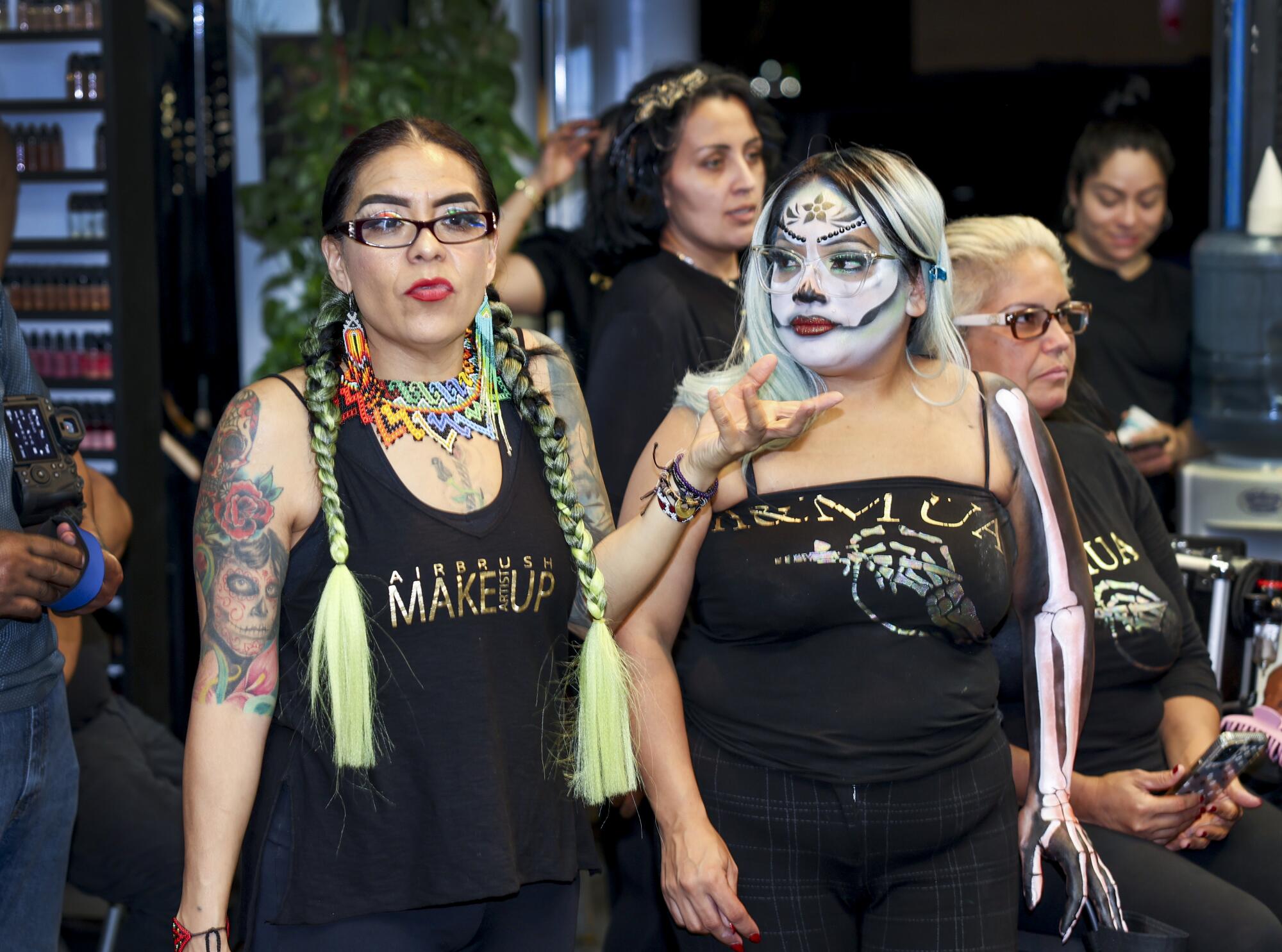
“We don’t do just regular face painting — we call it airbrush face art,” said Livier Vera López, Ruben López’s wife and business partner. “It’s more dimensional, more alive. We try to cover as much skin as possible so it shows as a character, it doesn’t look human.”
Starting in late August, the pair ran classes back-to-back for 10 weeks. On Mondays, they taught special effects and Halloween makeup. On Tuesdays, Catrinas and Day of the Dead.
From early October through Black Friday, they’re booked up with events.
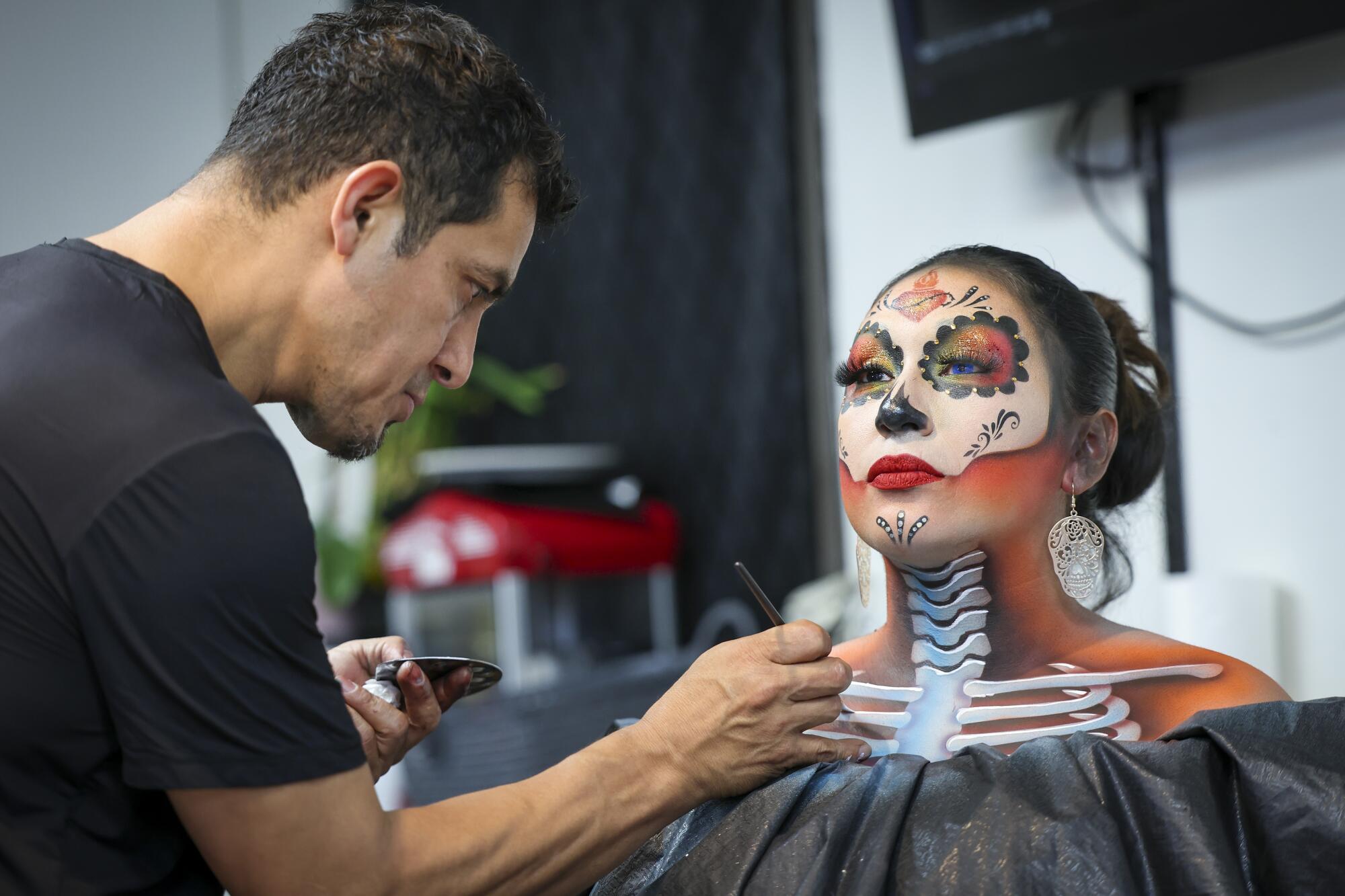
For Romero and her husband, transforming themselves and their children into spectral figures is a way of reclaiming a part of their culture.
“It’s been a mission to reconnect, and to know how to do this properly, to do it respectfully,” she said. “Living it and experiencing it is a feeling that you don’t forget. It’s more than just dressing up and doing makeup.”
But as the pandemic recedes, experts say newcomers — many with no ties to the practice — are turning to Day of the Dead to process the loss of loved ones to COVID.
“We’ve all been affected by deaths in the pandemic, so death is just closer to us now,” said Hudson, the Chapman professor. “Other people are also seeing it as a moment to honor their dead and their ancestors.”
As the tradition seeps into dance clubs, Disney films and Target aisles, alarm over appropriation has grown.
“As a Mexican American, it used to drive me a little crazy seeing white folks celebrate Day of the Dead,” Sandoval said. Although he thinks many come for the right reasons, “I know [some] people are showing up and participating because it’s really … trendy.”
That trend is especially visible this year, as participants flock to both Día de los Muertos and Halloween events in record numbers.
“Day of the Dead is not Halloween,” Sandoval said. “But there’s no denying that from a cultural roots level, they’re intimate cousins.”
For Camarena, the novice scare actor, Halloween horror is simply another window into the world beyond.
“It makes you wonder what other things are out there that people don’t think about every day,” he said.
Plus, it’s fun.
“It’s dope to be scared,” Camarena said. “It makes you feel alive.”
More to Read
Sign up for Essential California
The most important California stories and recommendations in your inbox every morning.
You may occasionally receive promotional content from the Los Angeles Times.












